Pin tumbler lock
The pin tumbler lock is a lock mechanism that uses pins of varying lengths to prevent the lock from opening without the correct key. Pin tumblers are most commonly employed in cylinder locks, but may also be found in tubular pin tumbler locks (also known as radial locks or ace locks).
.jpg.webp)
History
The first known example of a tumbler lock was found in the ruins of the Palace of Khorsabad in Iraq.[1] Basic principles of the pin tumbler lock may date as far back as 2000 BC in Egypt; the lock consisted of a wooden post affixed to the door, and a horizontal bolt that slid into the post. The bolt had vertical openings into which a set of pins fitted. These could be lifted, using a key, to a sufficient height to allow the bolt to move and unlock the door.[2] This wooden lock was one of Egypt's major developments in domestic architecture during classical times.[1]

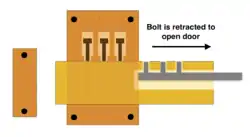
Such a lock, however, may be defeated by lifting the pins uniformly beyond the unlatching point. In 1805, the earliest patent for a double-acting pin tumbler lock — one where lifting the pins too much or too little prevented opening — was granted to American physician Abraham O. Stansbury in England. It was based on earlier Egyptian locks and Joseph Bramah's tubular pin tumbler lock. Two years later, Stansbury was granted a patent in the United States for his lock.[3]
In 1848, Linus Yale Sr. invented the modern pin-tumbler lock.[4] In 1861, Linus Yale Jr., inspired by the original 1840s pin-tumbler lock designed by his father, invented and patented a smaller flat key with serrated edges as well as pins of varying lengths within the lock itself, the same design of the pin-tumbler lock in use today.[5]
Design
The pin tumbler is commonly used in cylinder locks. In this type of lock, an outer casing has a cylindrical hole in which the plug is housed. To open the lock, the plug must rotate.
The plug has a straight-shaped slot known as the keyway at one end to allow the key to enter the plug; the other end may have a cam or lever, which activates a mechanism to retract a locking bolt. The keyway often has protruding ledges that serve to prevent the key pins from falling into the plug, and to make the lock more resistant to picking. A series of holes, typically five or six of them, are drilled vertically into the plug. These holes contain key pins of various lengths, which are rounded to permit the key to slide over them easily.
Above each key pin is a corresponding set of driver pins, which are spring-loaded. Simpler locks typically have only one driver pin for each key pin, but locks requiring multi-keyed entry, such as a group of locks having a master key, may have extra driver pins known as spacer pins. The outer casing has several vertical shafts, which hold the spring-loaded pins.
When the plug and outer casing are assembled, the pins are pushed down into the plug by the springs. The point where the plug and cylinder meet is called the shear point. With a key properly cut and inserted into the groove on the end of the plug, the pins will rise causing them to align exactly at the shear point. This allows the plug to rotate, thus opening the lock. When the key is not in the lock, the pins straddle the shear point, preventing the plug from rotating.
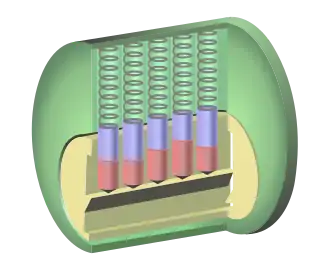

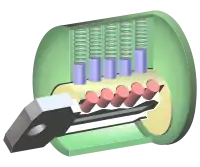
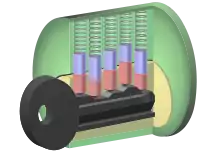
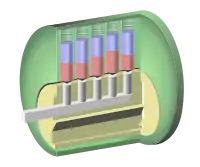
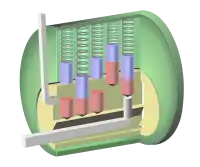
Cylinder locks
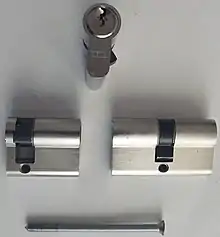
Commonly pin tumbler locks are found in a cylinder that can be easily unscrewed by a locksmith to facilitate rekeying. The first main advantage to a cylinder lock, also known as a profile cylinder lock or euro, is that the cylinder can be changed without altering the boltwork hardware. Removing the cylinder typically requires only loosening a set screw, then sliding the cylinder from the boltwork. The second is that it is usually possible to obtain, from various lock manufacturers, cylinders in different formats that can all be used with the same type of key. This allows the user to have keyed-alike, and master-keyed systems that incorporate a wide variety of different types of lock, such as nightlatches, deadbolts and roller door locks.
Typically, commercial padlocks can also be included, although these rarely have removable cylinders. Standardised types of cylinder include:
- rim-mounted (also known as night latch) cylinders
- Euro cylinders
- key-in-knobset cylinders
- Ingersoll-format cylinders
- American, and Scandinavian round mortise cylinders
- Scandinavian oval cylinders
There are also standardised cross-sectional profiles for lock cylinders that may vary in length - for example to suit different door thicknesses. These profiles include the europrofile (or DIN standard), the British oval profile and the Swiss profile
Other varieties
A tubular pin tumbler lock is a pin-tumbler lock with a round keyway.
A dimple lock is a pin tumbler lock where the bitting is located on the side of the key, rather than the top.[6]
Master keying
A master-keyed lock is a variation of the pin tumbler lock that allows the lock to be opened with two (or more) different keys. This type is often used for doorlocks in commercial buildings with multiple tenants, such as office buildings, hotels, student accommodation and storage facilities. Each tenant is given a key that only unlocks their own door, called the change key, but the second key is the master key, which unlocks all the doors, and is usually kept by the building manager, so they can enter any room in the building.
In a master-keyed lock, some or all of the shaft hole in the lock have three pins in them instead of two. Between the driver pin and the key pin is a third pin called the spacer pin. Thus each pin line has two shear points, one where the driver and spacer pins meet, and one where the spacer and key pins meet. So the lock will open with two keys; one aligns the first set of shear points and the other aligns the second set of shear points. The locks are manufactured so one set of shear points is unique to each lock, while the second set is identical in all the locks. A more secure type of mechanism has two separate tumblers, each opened by one key.
More complicated master-key lock systems are also made, with two or more levels of master keying, so there can be subordinate master keys that open only certain subsets of the locks, and a top-level master key that opens all the locks.
Vulnerabilities
Lock picking
The basic pin tumbler lock alone is vulnerable to several lock picking methods, the most straightforward being lock bumping and snap guns. To combat this, many higher security cylinders incorporate the use of a variety of specialised pins, collectively known as security pins, that are designed to catch in the lock cylinder if a snap gun or bump key is used.
Lock snapping
In 2009, West Yorkshire saw the start of lock snapping which is a method of forced entry that certain types of cylinder locks are vulnerable to, such as the euro cylinder which are commonly found on uPVC doors in Europe.[7] Lock snapping involves applying a strong torque force to the lock cylinder, usually with a pair of locking pliers, thereby breaking the mechanism and allowing access to the latch.[8] It can take between 50 seconds and 2 minutes to snap the lock and gain entry.[7][9] Police in the UK have estimated that around 22 million doors throughout the country could be at risk from lock snapping.[10]
Lock snapping is possible when the lock has a weakness where the retaining bolt passes through a thinner part of the lock. A recent development is to build a lock with a front section that snaps off the main body, leaving enough of the mechanism behind to prevent access to the operating latch. Some designs feature more than one sacrificial section which can stop the door from being opened from the attacked side (even with the key) while allowing the door to be opened from the other side.
Blowtorch burglary
Criminals utilise a small blow torch to target the area of uPVC or composite material surrounding the euro lock and door handle. The reason for this is to create a hole deep enough to reach deep into the door concentrating on the euro lock area. The goal once having created the hole is to reach with mole grips deep past any sacrificial lines of an inferior euro cylinder lock. The weak point of any euro lock is the centre screw hole which essentially holds the lock in place but also above this centre screw hole is the euro locks cam switch which is the switch that locks and unlocks your door. Once past the initial sacrificial lines of the euro lock, the burglar applies pressure to the screw hole area located in the centre of the cylinder lock, which then breaks easily as per a standard lock snapping method.[11]
Protection against vulnerabilities
Cylinders that meet either Sold Secure SS312 Diamond or TS007 3 Star standard will protect against drilling, picking, bumping, snapping,[12] and plug extraction methods of attack.[13]When fitting uprated cylinder door locks it is advisable to make sure they are paired with an effective security door furniture (handle).[14]
See also
- Disc tumbler lock
- Key relevance
- Lock picking
- Magnetic-coded lock
- Wafer tumbler lock
Early patents
- U.S. Patent 8,071 – Lock
- U.S. Patent 9,850 – Lock and key
- U.S. Patent 31,278 – Lock
References
- James, Peter, and I. J. Thorpe. Ancient Inventions. New York: Ballantine, 1994. Print.
- Locksmithing: From Apprentice to Master. McGraw-Hill Professional. 22 October 1994. p. 79. ISBN 9780070516458.
- The Complete Book of Home, Site, and Office Security: Selecting, Installing, and Troubleshooting Systems and Devices. McGraw-Hill Professional. 2006. p. 11. ISBN 9780071467445.
- The Geek Atlas: 128 Places Where Science and Technology Come Alive. O'Reilly Media, Inc. 21 May 2009. p. 445. ISBN 9780596555627.
- "Inventor of the Week Archive". Massachusetts Institute of Technology. Archived from the original on 2003-03-02.
- Pulford, Graham (2007). High-Security Mechanical Locks: An Encyclopedic Reference. Butterworth-Heinemann. pp. 116–117. ISBN 9780080555867. Retrieved 29 October 2018.
- "37p locks no match for Huddersfield criminals, warns W Yorks Police chief". Huddersfield Daily Examiner. 3 November 2009. Retrieved 28 May 2015.
- "Advice relating to Euro cylinder locks - North Yorkshire Police". 2013-07-27. Archived from the original on 2013-07-27. Retrieved 2017-07-07.CS1 maint: bot: original URL status unknown (link)
- "Rise in 'lock snapping' burglaries in West Yorkshire". BBC News. Retrieved 2016-03-16.
- "Police Advice on Lock Snapping - Lincolnshire Police". 2013-08-10. Archived from the original on 2013-08-10. Retrieved 2017-07-07.CS1 maint: bot: original URL status unknown (link)
- "Blowtorch burglary". www.shefflock.co.uk. Retrieved 2020-02-28.
- "What is Most Secure Lock To Prevent Lock Snapping?". www.locksmiths.co.uk. Retrieved 2019-09-26.
- "dhf | TS 007". www.dhfonline.org.uk. Retrieved 2019-01-20.
- "Anti Snap Locks". https://crimecrackdown.co. Retrieved 2021-01-12.